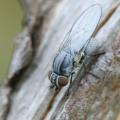Diptera.info :: Identification queries :: Diptera (adults)
Who is here? 1 guest(s)
|
Bombyliidae 2
|
|
| lynkos |
Posted on 17-08-2006 19:13
|
|
Member Location: Rome, Italy Posts: 466 Joined: 20.06.05 |
At least I think it's a Bombyliidae from the way it flew and the long proboscis (not visible in the photograph). It was BIG, about 17 mm long, photographed near Rome, Italy. Thanks, Sarah |
| Zeegers |
Posted on 17-08-2006 19:44
|
|
Member Location: Soest, NL Posts: 18914 Joined: 21.07.04 |
Hi Sarah It is a beautiful Bombyllidae, however, more of the 'short proboscis' subfamily. I think you are looking by mistake at the left front tarsus ? To me, it seems to be in Anthracinae, but leave that to the experts. Theo Zeegers |
|
|
|
| lynkos |
Posted on 17-08-2006 20:04
|
|
Member Location: Rome, Italy Posts: 466 Joined: 20.06.05 |
In fact the proboscis doesn't show in the foto, but I remember it as quite long. I'm looking through my discarded shots to see if there's one where you can see it better. If there is, I'll post it later, Sarah |
| lynkos |
Posted on 17-08-2006 20:06
|
|
Member Location: Rome, Italy Posts: 466 Joined: 20.06.05 |
Just taken a look, unfortunately all the shots are from the back. It was VERY nervous and flighty, typical Bombyliidae behaviour, and it took me an age to creep up on it  , Sarah , Sarah |
| Tony Irwin |
Posted on 17-08-2006 20:34
|
|
Member Location: Norwich, England Posts: 7276 Joined: 19.11.04 |
I suspect this is Satyramoeba hetrusca. I think David Gibbs is more familiar with this species, so hopefully he can confirm this.
Tony ---------- Tony Irwin |
|
|
|
| lynkos |
Posted on 18-08-2006 04:44
|
|
Member Location: Rome, Italy Posts: 466 Joined: 20.06.05 |
Thanks Tony, let's hope David can confirm, Sarah |
| David Gibbs |
Posted on 18-08-2006 11:23
|
|
Member Location: Bristol, UK Posts: 833 Joined: 17.06.06 |
looks just like my specimens of Satyramoeba hetrusca and as this is the only European species in the genus i think you can be confident of this det. |
|
|
|
| digitalg |
Posted on 18-08-2006 11:52
|
|
Member Location: Portugal Posts: 51 Joined: 31.07.06 |
David, I did not know this was the only european species in this genus! That leaves no doubts about this other fly you also commented: http://www.dipter...ad_id=2946 Do you have any records about size variability on this species, because I'm pretty sure "mine" was bigger than 17mm Thank you Armando Fraz„o http://bugs.digit... |
| Susan R Walter |
Posted on 18-08-2006 12:48
|
|
Member Location: Touraine du Sud, central France Posts: 1802 Joined: 14.01.06 |
Maybe it's just the angle of the shots, but Armando's fly seems to have a very small head for the size of the body and Sarah's fly does not give this impression. Also, do these matt black Bombyliidae really fade to that sort of bronzey colour? I am just thinking here of my smaller Thraxan, from Australia - I saw lots of these, and never other than the smart black and white. Mind you - the wing venation on Sarah and Armando's flies appears the same, so David must be right.
Susan |
| lynkos |
Posted on 19-08-2006 04:19
|
|
Member Location: Rome, Italy Posts: 466 Joined: 20.06.05 |
Actually Armando, 17 mm is a conservative estimate based on memory and it may well have been bigger. In fact, being BIG was the first thing that attracted my notice  ! Sarah ! Sarah |
| digitalg |
Posted on 20-08-2006 11:55
|
|
Member Location: Portugal Posts: 51 Joined: 31.07.06 |
Well, we may really be looking at the same fly. Yesterday I went for a walk and could take a good look at some Xylocopa violacea, I believe these bombyliids mimic them. Their size is my only real measure of the size of the fly I photographed, and the especimen of X. violacea I've seen average a little below 25mm long. I guess we are getting into a meeting point and I'll be naming mine also S. hetrusca 
Armando Fraz„o http://bugs.digit... |
| Jump to Forum: |













